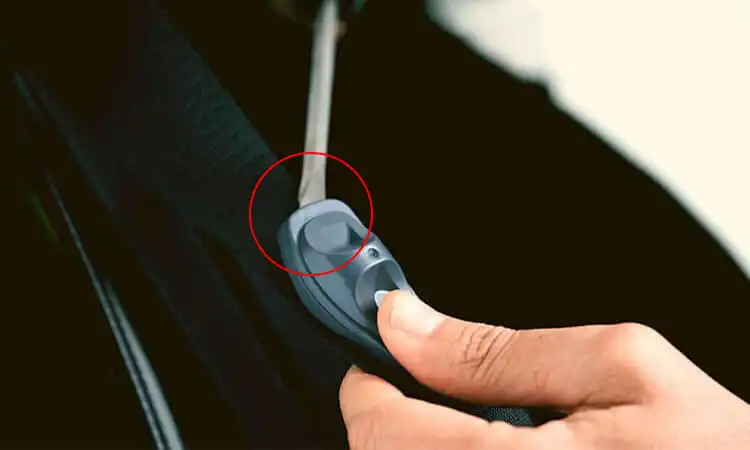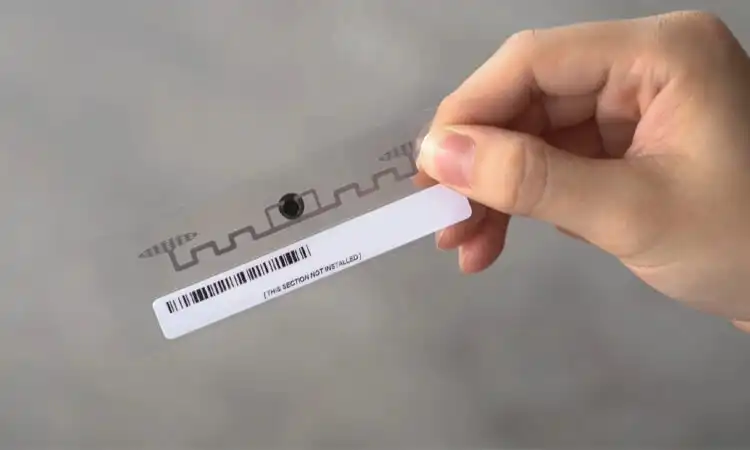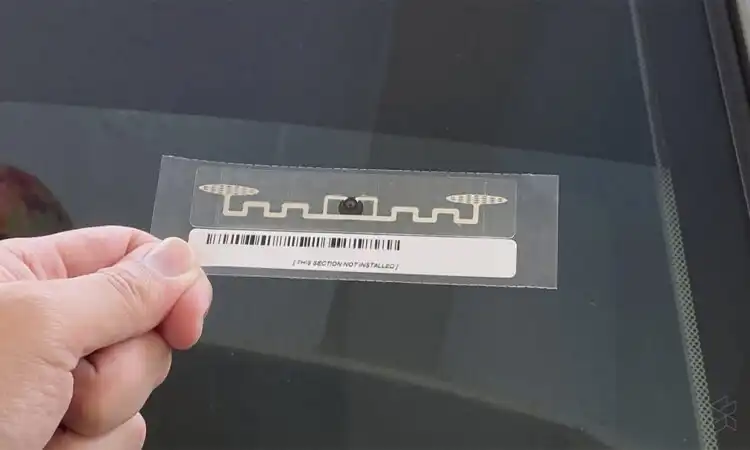RFID tags are commonly used in cars for various purposes, such as toll payment, tracking, and access control. However, there may be situations where someone needs to remove an RFID tag from their car, such as when selling the car or for privacy and security concerns. In this blog post, we will provide a step-by-step guide on how to remove RFID tags from cars safely and effectively. We will also cover the potential risks and legal considerations involved in removing an RFID tag from a car. Whether you’re looking to remove an RFID tag from your car or are simply interested in learning more about this technology, this post will provide a useful overview of how to remove an RFID tag from a car.
Identifying RFID tags in cars is an important first step in removing them. RFID tags can be difficult to locate, as they can be embedded within the vehicle or hidden in inconspicuous locations. Visual inspection combined with RFID detection tools provides the most comprehensive approach to finding tags for removal.
- Thoroughly check the windshield, as RFID tags are frequently attached near the glass’s top center or bottom edge. Closely examine the entire windshield surface for any small rectangular or circular components fixed to the glass.
- Carefully inspect the keyless entry remote, as some RFID tags are integrated within these devices. Look for buttons, ports, symbols, or seams on the remote, indicating a tag could be embedded or mounted inside.
- Meticulously search the dashboard, especially on the driver’s side, for RFID tags mounted or embedded on the dashboard or protruding from crevices. Look for small rectangular, circular, or square components attached to or protruding from the dashboard.
- Inspect each door intently for RFID tags, typically situated near the door handle, lock, keyhole, or window regulators. Identify any small rectangular, circular, or square devices attached to or embedded within the doors.
- Use an RFID detector or tag finder to help locate concealed tags if visual searches have been unsuccessful. These tools can detect nearby RFID tags to help pinpoint their position for removal.
You need to note that not all vehicles contain RFID tags, and both tag type and placement can differ substantially between makes, models, model years, and optional features. Research your vehicle’s specifications or contact the manufacturer for details on potential RFID tags.
Related Articles: Everything You Should Know About RFID Tags for Car
There are compelling reasons why vehicle owners may opt to remove RFID tags from their cars. Privacy, security, and personal preference are the most common motivations for removing RFID tags.
Some people have legitimate privacy and security concerns about RFID tags allowing unauthorized tracking of a vehicle’s location and movements. Removing the RFID tag helps prevent unwanted monitoring and provides peace of mind.
Transferring ownership of a vehicle likewise warrants RFID tag removal to avoid providing access to personal information or enabling continued tracking of the new owner’s whereabouts and driving habits. Without removing the RFID tag, a new owner would inherit the tag along with the vehicle, compromising their privacy.
Occasionally, an RFID tag may become damaged, defective, or malfunction in a way that hinders normal vehicle access or operation. In these cases, removing the non-functional tag is necessary to repair or replace it, restoring full use of vehicle features and convenience.
A small percentage of vehicle owners simply prefer not to use RFID technology and find tag removal preferable for personal reasons, with no security, privacy, or other functional concerns. The personal choice regarding technology usage should be respected.
Leaving an RFID tag in an unused vehicle poses risks of its own. Without an owner authorizing access, an RFID tag could be exploited by hackers, thieves, or other malicious actors to gain unlawful entry into the vehicle or access privileged information. Removing tags from unused cars helps mitigate these risks.
If you need to remove an RFID tag from your car, here’s a step-by-step guide to help you do it safely and effectively:

RFID tags are often attached near the top of the windshield, on the rearview mirror, dashboard, or keyless entry remote for maximum range. Look for small rectangular, circular, or square components with attached antennas. Thoroughly inspect the entire vehicle to locate any RFID tags before proceeding to removal.
Gathering Necessary Tools and Precautions
You will need a flathead screwdriver, pliers, scissors, wire cutters, and a replacement RFID tag (optional). Be sure to disconnect the vehicle battery for safety before removal to avoid electric shock or system damage.
Disconnecting the Battery
Locate the vehicle battery, typically in the engine bay, and disconnect both the positive and negative battery terminals to disable power before removing any RFID tags.
The method for removing an RFID tag depends on its location and attachment.
- Windshield/mirror tags: Use a flathead screwdriver to carefully pry tags off without breaking the glass. For stubborn tags, twist with pliers to loosen the adhesive before pulling it off.
- Dashboard/keyless entry tags: Gently pry up one edge of the tag with a flathead screwdriver and peel it off. Use pliers to twist and remove any remaining adhesive.
- Hardwired tags: You may need to cut the wires attaching the tag to the vehicle wiring harness before prying or twisting off the tag. Use wire cutters to cut the wires as close to the tag as possible. Seal any exposed wire ends to prevent short circuits.
Related Articles: Windshield Tag Buying Guide
Replacing a Replacement RFID Tag (Optional)
If installing a replacement RFID tag, clean and dry the attachment surface, then adhere to the new tag in place according to the manufacturer’s recommendations or a similar attachment method as the original tag.
Reconnecting the Battery and Testing the Vehicle
Reconnect the positive and negative battery terminals, then start the vehicle to ensure the proper functioning of all features including locks, alarms, keyless entry, and immobilizer systems before driving.
Legal Considerations
Be aware that removing an RFID tag may void your vehicle warranty or lease terms and, in some states, requires disclosure when selling a used vehicle. Check your specific laws regarding RFID tag removal and any legal liabilities or responsibilities. Additionally, be sure to dispose of any removed RFID tags properly and securely to avoid any potential security risks.
If you’ve removed a sticker from your car’s headlight, you may be left with some adhesive residue that needs to be removed. Fortunately, you don’t need to spend much money at the auto detail shop to get it done. Here’s how you can remove the adhesive residue in just a few minutes:

Apply Heat (Optional but Helps)
Gently heating the adhesive with a heat gun, hair dryer, or hot water will soften the bond and make residue easier to wipe away. Be very careful not to scorch the plastic headlight surface. Holding a cup of hot (not boiling) water over the sticker for several minutes can help soften the adhesive without direct heat.
Use a Non-abrasive Adhesive Remover (Optional)
For tough residue, apply a citrus- or glycol-based adhesive remover according to directions and let it soak in for several minutes to help loosen the adhesive’s hold before wiping it away. Test in an inconspicuous area first to check for damage.
Isopropyl alcohol also works well and evaporates quickly without leaving behind chemical smells. Avoid harsh, abrasive, or acetone-based products that can damage headlight plastic and coatings.
Wipe Off Residue with a Microfiber
Use a microfiber cloth, non-abrasive sponge, or soft-bristled brush to wipe away adhesive residue and remaining sticky bits gently. Gently rub in a circular motion, applying light pressure.
Scrub in a Pattern
If the remaining adhesive is stubborn, make multiple passes with the cloth, heating, and re-applying remover as needed. Be patient throughout the whole process to avoid damaging the headlight surface.
Inside and Re-treat (If Needed)
For tough cases, rinsing headlights with water after wiping and repeating the heating/applying/wiping steps can further loosen stubborn residue for complete removal. Dry headlights thoroughly when done to prevent water spots.
Removed RFID tags contain sensitive data that should never be discarded irresponsibly. RFID tags must be disposed of properly according to the following guidelines to avoid potential privacy, security, and identity theft risks:

- Do not throw RFID tags in the trash: RFID tags store information that can be exploited to track locations, access accounts, or steal identities. Always dispose of tags securely instead of throwing them in the landfill.
- Destroy RFID tags: The most secure disposal method is physically destroying the tag. Use a heavy object like a hammer, brick, or anvil to crush the tag into small unreadable pieces. Scissors or heavy-duty shears can also be used to cut the tag into multiple small sections. Destroyed tags cannot be scanned or decrypted.
- Recycle RFID tags (if possible): Some RFID tags are made of recyclable materials and can be recycled according to local regulations. Check with recycling centers regarding recycling options for RFID tags in your area. Recycled tags still pose some risk but are less likely to be misused than tags in landfills.
- Return tags to the manufacturer (if offered): A few manufacturers offer RFID tag return and recycling/disposal programs. Contact tag manufacturers regarding any disposal or return options they may provide for their RFID tags. Manufacturer disposal helps ensure tags are handled securely, but it is not always available.
- Store tags securely (if keeping): If storing removed RFID tags for records, keep them in a locked safe, lock box, or cabinet in a location not visible or accessible to others. Secure storage mitigates but does not eliminate the risks of the tags’ sensitive data being accessed or the tags themselves going missing.
Privacy and security concerns are increasingly important today, and removing an RFID tag from your car is one way to protect yourself. By following the step-by-step guide provided in this post, you can safely and effectively remove an RFID tag from your car. Remember to consider the potential legal implications and dispose of removed RFID tags properly to avoid any potential security risks. We hope this guide has helped provide you with the information you need to remove RFID tags from your car with confidence.
About How to Remove RFID Tag From Car FAQs
-
What is an RFID tag?
An RFID tag is a radio-frequency identification microchip for tracking vehicles, merchandise, or other assets. Many cars have RFID tags embedded for keyless entry, anti-theft or other features.
-
Why remove an RFID tag from my car?
Privacy, security, and personal concerns are common reasons for RFID tag removal. Tags can potentially be used to track vehicle locations and movements. Removing tags helps prevent unauthorized monitoring.
-
Where are RFID tags typically located in cars?
Common spots for RFID tags include the windshield, dashboard, keyless entry remote, door jambs, and trunk. Thoroughly searching the entire vehicle is the only way to locate all tags.
-
How do I disconnect the car battery before removing an RFID tag?
The vehicle battery must be disconnected for safety to avoid electric shock or system damage when removing RFID tags. Locate the battery, typically in the engine bay, and disconnect the positive and negative terminals.
-
What tools do I need to remove an RFID tag?
Basic tools include a flathead screwdriver, pliers, wire cutters, hammer or crusher, and replacement tags (optional). Screwdrivers and pliers are used to pry off surface tags, while hammers/crushers destroy tags for disposal. Wire cutters cut any wires attached to hardwired tags.
-
How do I safely destroy an RFID tag?
The most secure method is destroying tags by crushing, shredding, or incinerating them. Heavy objects like a hammer, anvil, or brick can crush tags. Wire cutters, scissors, or shredders can cut tags into small unreadable pieces. Incinerators or high-intensity heat can burn tags until unreadable.
-
How should I dispose of removed RFID tags?
Properly destroy tags before disposal in dumpsters, landfills, or recycling. Crushed or shredded tag pieces can be recycled where accepted. Return some tags to manufacturers for disposal. Securely store any tags kept for records. Discarded tags must not be readable to prevent misuse.
-
Can removing an RFID tag void my vehicle warranty?
Removing an RFID tag without manufacturer approval can void your vehicle warranty or service contract. Most manufacturers require tags for security, tracking, and diagnostics features covered under your warranty. Check with your dealer regarding any warranty implications before tag removal.
-
Is removing an RFID tag legal?
Laws regarding modifying or removing vehicle components like RFID tags may apply in some areas. A few states have laws requiring the disclosure of removed RFID tags during vehicle sales. Apart from any applicable laws, removing a tag you own is typically considered legal. But it is best to check your local regulations to be sure.









